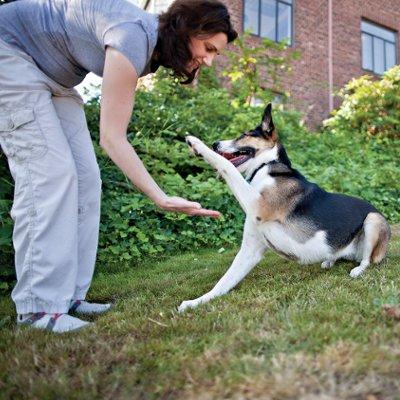By Michelle Mullins, CPDT-KA, PetSafe Training and Behavior Education Department Manager
Training a dog takes patience and practice. Training a dog who is deaf can be even more challenging. People often think it is too hard to train the dog or because deaf dogs startle easily, or they believe the dogs are aggressive. Unfortunately, many dogs are given up on because of partial or total hearing loss. These dogs can live the same happy healthy lives and be wonderful pets. They can do all the same activities a hearing dog can do; the training just needs some modification to work for them!
Deafness in dogs has a variety of causes including genetic defect, injuries, infection and aging. Hearing loss can be partial or complete. There are a few at home tests you can try to help determine if your dog has hearing loss but it can be difficult to tell especially if the dog has learned to adapt. If you suspect your dog is deaf or is losing their hearing please consult your veterinarian to determine the underlying cause that may need medical treatment. Most veterinarians and trainers will support you in keeping your dog and finding ways to work through the challenges.
Living with and training your deaf dog means you will need to change the way you communicate with your dog and is certainly doable. These dogs use their other senses sight, smell and feel to help them. They may feel the vibration of you approaching or detect your scent. They can be trained to understand hand signals for cues like sit, stay and any other behavior you want to teach.
Even though these dogs learn to rely on other senses they may be more easily startled by touch or become anxious if he suddenly realizes you are near him. Just by being aware of this and practicing you can help him get used to these things. Give your dog time feel the vibration of your approach and catch your scent when you are close. Reward him with a treat for noticing your approach. Always touch him gently on the shoulder or on the back above the back legs when you need to and reward him for turning toward you. All members of your family should practice this approach. You will also want to educate others about your dog’s special needs and how to approach him. When leaving the room or area you should also get his attention so he watches you leave. This will help him not be anxious because he is suddenly alone when he thought you were there. 
Training a deaf dog takes some patience and you will need to rely on silent forms of communication. While this may be very different for you as the trainer the dog picks this up just as quickly as verbal cues and sounds.
In order to use visual cues and markers the dog needs to be looking at you. So getting the dogs attention is one of the first things you will want to work on. You can use a gentle touch if the dog is close enough.
To get his attention from a distance you can wave your arm, use a flashing light (on, off, on), toss a toy into his line of vision or consider using a vibrating collar. A vibration collar can provide a light vibration that can act as a pager. The dog can be trained to respond to the vibration by looking for you and getting a reward for doing so.
Once you can get your dog’s attention you can use hand signals for cues such as sit, stay and come. Many people use hand signals for hearing dogs. The hand signals should be clear and unique for each behavior you are teaching. Just like a verbal cue for a behavior like sit, for example, you present the cue(a hand signal), wait for the behavior to be offered(sit) and reward the dog immediately when he does the behavior(sit).
Clicker or marker training is a great choice for any dog. Instead of an audible clicker you would choose a flashlight, hand signal (thumbs up), etc. that becomes your click or marker to communicate “YES” and is followed by a treat reward to teach new behaviors. Check out Karen Pryor’s clicker training website for information on clicker training for all dogs even those with hearing loss.
The Deaf Dog Education Action Fund has great information, tips and resources for living with and training your deaf dog. Both these sites can help you find a trainer to work with you and your dog. Your hearing impaired dog can be the same amazing companion dog as any other dog. They can play tug, fetch a ball and snuggle on the couch. They can learn and participate in sport and therapy activities, too! All they need is your love, support and patience.






